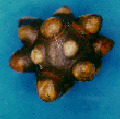


Louis C. Herring Laboratory Information
Analysis of urinary calculi is an essential step in the examination and
initial treatment of the patient with kidney stones (urolithiasis). Knowledge
of the composition of calculi yields fundamental information concerning
the pathogenesis of the disease, including metabolic abnormalities, presence
of infection, possible artifacts, and even drug metabolism. Our report
to the physician notes the weight, size, and shape of stones, the constituents
of the stone and their order of deposition, the presence of a nidus and
its composition, the presence of foreign bodies or artifacts, and the presence
and identification of unusual components, such as drugs and drug metabolites.
The need for specific analysis increases as progress is made in treating
various forms of urolithiasis and as interrelationships among predisposing
factors become evident.
We at Louis C. Herring Laboratory use an integrated approach to determine
completely the composition of each urinary calculus (see below). The approach
depends on the appropriate combination of conventional macroscopic and
microscopic techniques with physical techniques, such as optical crystallography,
chemical tests, x-ray diffraction, infrared spectroscopy, fluorescence,
and chromatography. Each method has merit in specific situations. Whereas
a single method may not be adequate for all analyses, a combination of
methods used in a complementary fashion may be relied on for accurate results.
The table below is an outline of the general procedure used in our laboratory
for analyzing urinary stones; it leads to a semiquantitative estimate of
stone composition.
General Procedure for Analyzing Urinary Stones
-
Macroscopic examination-- weight, size, shape, number (all calculi)
-
Microscopic examination-- nidus, order of deposition of constituents, estimate
of composition, removal of minor components for physical and chemical tests
(all calculi)
-
Photomicroscopy, when desired.
-
* Polarization microscopy
-
* Infrared spectroscopy
-
* X-ray diffraction
-
* Ultraviolet/visible spectroscopy
-
* Chemical tests
-
* Fluorescence and chromatography
-
Final, semiquantitative, modified estimate of composition from above results
* Selected samples, as needed.
Louis C. Herring and Co. Laboratory,the developer of the"Integrated
Analysis" approach to the analysis of urinary calculi offers to the
medical community the expertise of its highly trained technologists and
the assurance of professional crystallographic analyses that only time,
experience and dedication can produce.
Our services include:
Detailed semi-quantitative analyses
Identification of nidus
Component order of deposition
Drug metabolite investigation & identification
Analysis of minute specimens (no minimum size requirement)
Computer search availability for x-ray diffraction data
24-48 hour turn-around
Photos on request
Pre-addressed mailing containers, gratis, to U.S. and Canada
Reasonable fee

Reporting Analytical Results
The results of qualitative and semi-quantitative analyses are completed
24-48 hours after receipt of the specimen at Herring Laboratory. A descriptive
professional report, as above, is then forwarded. Replace with "Photomicroscopy
of the interior and exterior of the specimen is offered, if requested,
at a small additional charge.
Sample reports availiable on our internet server:
Mailing Specimens
Specimens should be air dried, then placed in a pre-addressed specimen
mailing container. Minute specimens may be placed in the gelatin capsule
provided. Mailing containers are supplied gratis in the USA and Canada.

No part of this information may be reproduced without written
permission.






 E-Mail L. C. Herring & Co. Laboratory
at stones@herringlab.com.
E-Mail L. C. Herring & Co. Laboratory
at stones@herringlab.com.